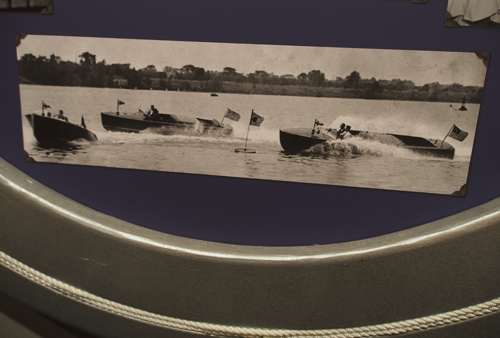Featured News - Current News - Archived News - News Categories
Part II
Story and photos by Alice Gerard
The Buffalo Launch Club was “a world-famous boating regatta spot” in the 1920s, said Grand Island Historian Jodi Robinson, who provided research for a program titled “Boats, Booze, and the Buffalo Launch Club in the 1920s,” to be held at 6 p.m. Saturday, Feb 25, at the Buffalo Launch Club.
“It was a fun time,” Robinson said.
“(Boat racing) was the equivalent of the NASCAR racing that is going on today,” said Tom Frauenheim of the Buffalo Launch Club’s heritage committee. “It was a big deal at the time. You start thinking about this. There was radio. There was no television. There were a lot of boating magazines. There was a lot of interest in the mechanical aspect of motors and stuff like that. How to make things go faster and better. These races here would attract 30,000 to 35,000 people up and down the river. They had excursion boats and tour boats out there, and these were in addition to the people being on shore here. The excursion boats and tour boats and the ferry boats were loaded with people.”

A photo of a past boat race at the Buffalo Launch Club.
••••••••
One of the most famous motor boating races of the time was not originally planned for Buffalo or Grand Island.
Frauenheim said, “Motor boating had just gotten going, maybe about 20 years before, in 1900, 1903. The racing was an important part of this. The people at the Launch Club were very enthusiastic. As it turns out, Carl Fisher, who was well known for starting the Indianapolis 500 racetrack in 1911, was a real enthusiast for boat racing.”
He also was a “leader in the Lincoln Highway, building a highway that would go from the East Coast to the West Coast,” Frauenheim said.
Frauenheim related that Fisher decided to sponsor a boat race that was held in 1921.
“They (the boats) have to do a minimum of 40 miles per hour,” he said. “They had to be a minimum of 32 feet. They had to be a boat that you could take out for a race and that you could take your family for a boat ride. So, this was the Fisher Trophy. It was a 150-mile race, and it was run over three days. Fifty miles each day. There was a lock put on your engine hatch. You couldn’t do any repairs or anything. They did it over three days to get the excitement going.
“Another feature of this is that it was in three different places. It was in Detroit, it was in Miami, and it was supposed to be in Lake George. I was always told that the people at Lake George didn’t have the funding to do it. The article in Motorboating Magazine said that their hotel was not ready. Whatever it is, Lake George was eliminated, and Ralph Sidway, who was a big racer and promoter of the Buffalo Launch Club, got the third leg of that race to come to Buffalo. That was an international race. It brought a lot of power to Buffalo.”
At the presentation, Frauenheim said, “We talk a little about the boats, but, mainly, we talk about the people. There were some people who lived around here who had a lot of money. They were, as I would say, the old school. They were 30 years or a little bit older. It was the Fisher Trophy race to begin with. Jim Allison (one of the founders of the Indianapolis Motor Speedway) got into it. They changed the name to Fisher-Allison Trophy. The trophy was a solid-gold 17-inch trophy. I got pictures of that. The City of Buffalo gave the Launch Club $2,500 to change the course so that it came up by Riverside Park.
“That’s a great area along the river where the elevation is high. People can see and all that. The other people involved in this were Humphrey Birge of Birge Wallpaper. Also Ed Grimm from the Peerless Marine Motor Company of Buffalo, New York. These were people from the gilded era. They had plenty of money. All of these people were wealthy, and they were products of the Gilded Age.”
Problems with racing began occurring, Frauenheim said, because smaller boats were not able to keep to perform or hold up like larger boats. To accommodate that issue, “the American Powerboat Association redid their rules. In 1922, they came out with this new Gold Cup. The new young guys at the Launch Club that were the sparkplugs behind all of this all had an aviation background. They were building engines. So those guys were all in their 20s. The engine had to be built and manufactured in the United States. It had to be made for marine use. What ended up happening is that Gar Wood came along and put an airplane engine in his boat. It had way more horsepower. It was a lot lighter. In 1926, it ended up killing the Fisher-Allison races. Would you want to race against somebody who had an airplane engine in his boat?”
Frauenheim said, "I was thinking of starting this thing out with ‘It was the best of times, and it was the worst of times.’ ”
Prohibition had an effect on boating. All alcoholic beverages were illegal from 1920-33. It was illegal to use a bottle of wine to christen a boat.
“We have these people who were so excited about boat racing, and you can’t have a beer. Come on, you know!” Frauenheim said.





























